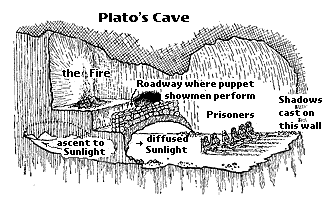
The Allegory of the Cave is an allegory used by the Greek philosopher Plato in his work The Republic to illustrate "our nature in its education and want of education". It is written as a dialogue narrated by Plato's friend Socrates and Plato's brother Glaucon at the beginning of Book VII. The Allegory of the Cave is presented after the metaphor of the sun and the analogy of the divided line. All three are characterized in relation to dialectic at the end of Book VII and VIII.
Plato lets Socrates describe a group of people who have lived chained to the wall of a cave all of their lives, facing a blank wall. The people watch shadows projected on the wall by things passing in front of a fire behind them, and begin to ascribe forms to these shadows. According to Plato's Socrates, the shadows are as close as the prisoners get to viewing reality. He then explains how the philosopher is like a prisoner who is freed from the cave and comes to understand that the shadows on the wall do not make up reality at all, as he can perceive the true form of reality rather than the mere shadows seen by the prisoners.
The Allegory may be related to Plato's Theory of Forms, according to which the "Forms" (or "Ideas"), and not the material world of change known to us through sensation, possess the highest and most fundamental kind of reality. Only knowledge of the Forms constitutes real knowledge. In addition, the Allegory of the Cave is an attempt to explain the philosopher's place in society: to attempt to enlighten the "prisoners".